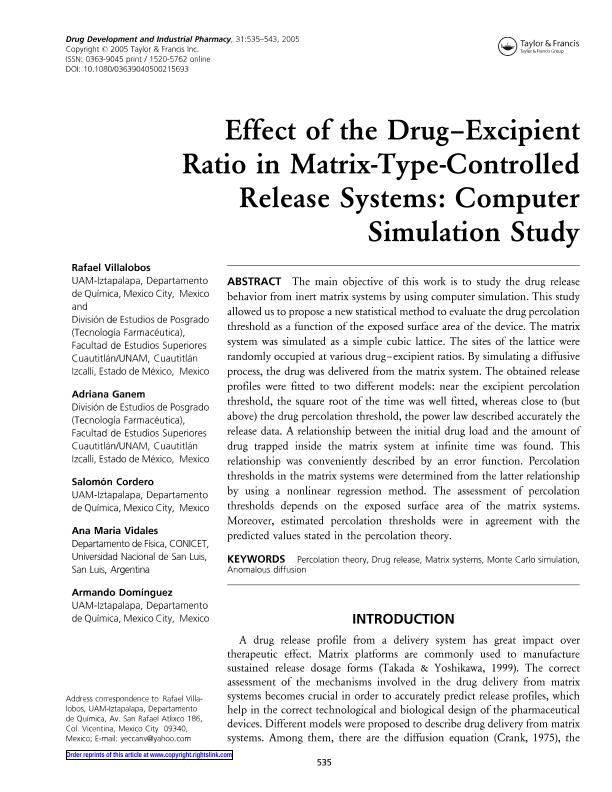Mostrar el registro sencillo del ítem
dc.contributor.author
Villalobos, Rafael
dc.contributor.author
Ganem, Adriana
dc.contributor.author
Cordero, Salomón
dc.contributor.author
Vidales, Ana Maria

dc.contributor.author
Domínguez, Armande
dc.date.available
2023-10-04T01:58:15Z
dc.date.issued
2005-12
dc.identifier.citation
Villalobos, Rafael; Ganem, Adriana; Cordero, Salomón; Vidales, Ana Maria; Domínguez, Armande; Effect of the drug-excipient ratio in matrix-type-controlled release systems: Computer simulation study; Taylor & Francis; Drug Development and Industrial Pharmacy; 31; 6; 12-2005; 535-543
dc.identifier.issn
0363-9045
dc.identifier.uri
http://hdl.handle.net/11336/214004
dc.description.abstract
The main objective of this work is to study the drug release behavior from inert matrix systems by using computer simulation. This study allowed us to propose a new statistical method to evaluate the drug percolation threshold as a function of the exposed surface area of the device. The matrix system was simulated as a simple cubic lattice. The sites of the lattice were randomly occupied at various drug-excipient ratios. By simulating a diffusive process, the drug was delivered from the matrix system. The obtained release profiles were fitted to two different models: near the excipient percolation threshold, the square root of the time was well fitted, whereas close to (but above) the drug percolation threshold, the power law described accurately the release data. A relationship between the initial drug load and the amount of drug trapped inside the matrix system at infinite time was found. This relationship was conveniently described by an error function. Percolation thresholds in the matrix systems were determined from the latter relationship by using a nonlinear regression method. The assessment of percolation thresholds depends on the exposed surface area of the matrix systems. Moreover, estimated percolation thresholds were in agreement with the predicted values stated in the percolation theory.
dc.format
application/pdf
dc.language.iso
eng
dc.publisher
Taylor & Francis

dc.rights
info:eu-repo/semantics/openAccess
dc.rights.uri
https://creativecommons.org/licenses/by-nc-sa/2.5/ar/
dc.subject
ANOMALOUS DIFFUSION
dc.subject
DRUG RELEASE
dc.subject
MATRIX SYSTEMS
dc.subject
MONTE CARLO SIMULATION
dc.subject
PERCOLATION THEORY
dc.subject.classification
Otras Ciencias Físicas

dc.subject.classification
Ciencias Físicas

dc.subject.classification
CIENCIAS NATURALES Y EXACTAS

dc.title
Effect of the drug-excipient ratio in matrix-type-controlled release systems: Computer simulation study
dc.type
info:eu-repo/semantics/article
dc.type
info:ar-repo/semantics/artículo
dc.type
info:eu-repo/semantics/publishedVersion
dc.date.updated
2023-07-07T20:34:25Z
dc.journal.volume
31
dc.journal.number
6
dc.journal.pagination
535-543
dc.journal.pais
Estados Unidos

dc.description.fil
Fil: Villalobos, Rafael. Universidad Autónoma Metropolitana; México
dc.description.fil
Fil: Ganem, Adriana. Universidad Autónoma Metropolitana; México
dc.description.fil
Fil: Cordero, Salomón. Universidad Autónoma Metropolitana; México
dc.description.fil
Fil: Vidales, Ana Maria. Universidad Nacional de San Luis; Argentina. Consejo Nacional de Investigaciones Científicas y Técnicas. Centro Científico Tecnológico Conicet - San Luis. Instituto de Física Aplicada "Dr. Jorge Andrés Zgrablich". Universidad Nacional de San Luis. Facultad de Ciencias Físico Matemáticas y Naturales. Instituto de Física Aplicada "Dr. Jorge Andrés Zgrablich"; Argentina
dc.description.fil
Fil: Domínguez, Armande. Universidad Autónoma Metropolitana; México
dc.journal.title
Drug Development and Industrial Pharmacy

dc.relation.alternativeid
info:eu-repo/semantics/altIdentifier/doi/http://dx.doi.org/10.1080/03639040500215693
dc.relation.alternativeid
info:eu-repo/semantics/altIdentifier/url/https://www.tandfonline.com/doi/abs/10.1080/03639040500215693
Archivos asociados
